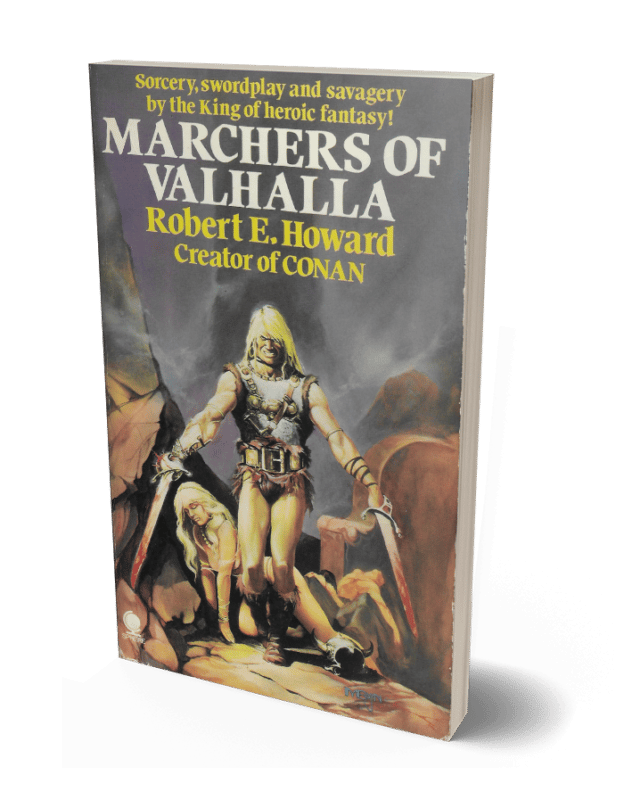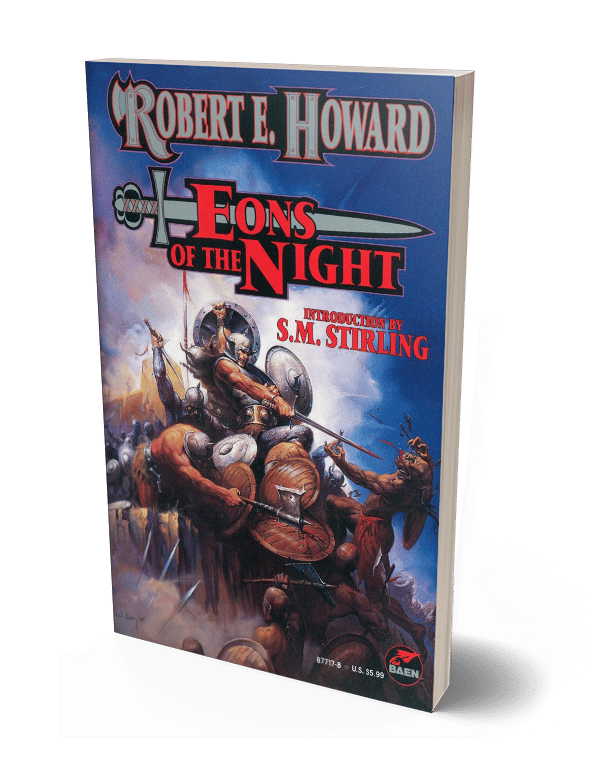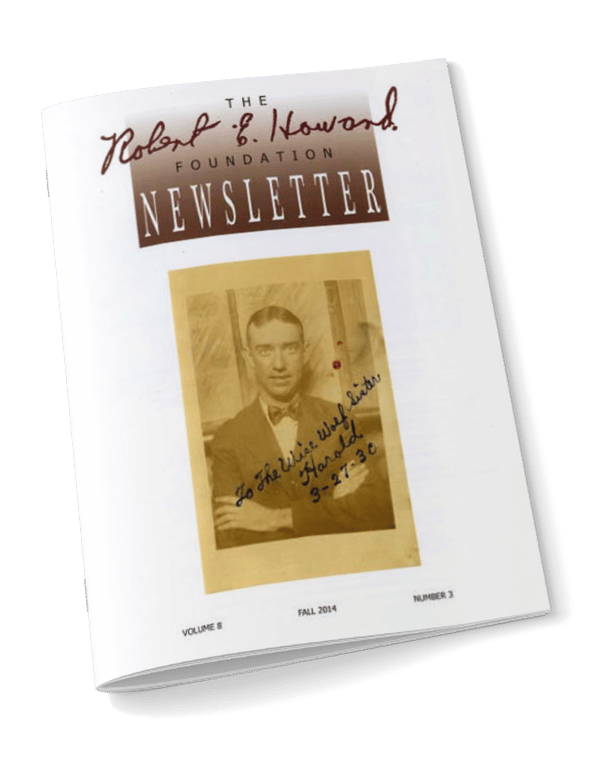Introduction
“Marchers of Valhalla” is one of Howard’s James Allison stories. In these tales, a modern man recalls past eras of his life from which he has been reincarnated, over and over again. Howard borrowed this conceit from Jack London, who employed it in “The Jacket,” also published as “The Star Rover.” As “Marchers” opens Allison is living in early 1930s Texas, despondent over his prosaic, banal existence. He has no opportunity for adventure or heroism, as the frontier has been settled, the great wars fought. Moreover, he has lost his leg to a riding accident, perhaps a metaphor for modern man’s impotence. Howard describes the low hills of the Texas landscape as “a dreary expanse… checkered with sterile fields where tenant farmers toil out their hideously barren lives in fruitless labor and bitter want.”
Howard was working on a preliminary outline for the story in April 1932. The story was sent to Weird Tales, but rejected circa May 1932. We learn about the rejection in a letter (#208) To H.P. Lovecraft, on May 24, 1932:
I’m enclosing a rhyme induced by recent Asiatic affairs; no hurry about returning it. Wright rejected the antediluvian Texas story; not enough weirdness about it.
It was later submitted to Oriental Stories, but returned on March 7, 1933, claiming it was “too much supernatural”.
The story
The story opens with James Allison, who, upon encountering a mysterious woman, is sent on a visionary journey into the past. He becomes Hialmar, a member of the Æsir, a group of powerful, golden-haired warriors. This transformation leads Hialmar and his fellow Æsir on a remarkable journey that spans diverse landscapes and confronts various civilizations.
Their journey eventually brings them to Khemu, a city ruled by treacherous priests who worship Ishtar. The Æsir warriors are initially welcomed and showered with gifts, including the company of women, as the city faces a threat from a fierce, red-haired king leading a horde of black warriors. Hialmar is captivated by Aluna, a handmaiden to the goddess Ishtar, marking the beginning of a complex emotional journey for him.
In a dramatic twist, the Æsir are betrayed by the city’s inhabitants, leading to a bloody and chaotic battle. Hialmar, in a frenzied state, discovers the true nature of Ishtar, a woman enslaved and worshipped as a goddess. The climax is cataclysmic as Poseidon, invoked by Ishtar, destroys the city in a fit of rage.
The story ends with Allison back in his time, pondering over his experience and the revelation that the woman he met was Ishtar herself, symbolizing eternal life and the cyclical nature of existence.
Comic book adaption - never published
These pages are part of Nestor Redondo’s unpublished art for the adaption of MARCHERS OF VALHALLA. This was meant for Cross Plains Comics, but they went out of business.
Thanks to Ed Chaczyk and Robert E. Howard Comics and Media News for sharing these. Ed also shared this information, which he had obtained from both Terry Allen, who received details from Roy Thomas, and John Cimino, who also received information from Roy Thomas, providing more details about “Marchers of Valhalla,” a project from the late 1980s:
- The project was divided into two parts.
- Nestor Redondo illustrated the first part, and it was completed.
- Unfortunately, Nestor Redondo passed away before he could illustrate the second part.
- Rey Garcia was chosen to complete the second part, and his style differed from Nestor Redondo’s.
- The project was intended for a Heroic Comics magazine that would have included both text and black-and-white comics.
- However, the magazine was never fully published.
- Only the splash page, featuring Robert E. Howard as the Allison character, was published in ALTER EGO #136.
- Roy Thomas never added the dialogue and captions for the second part, but he still has the pages, which are likely scattered in his drawers.
- Part 1 of the project is mostly together somewhere, although the photocopies may vary in quality.
- It’s uncertain if Dennis Mallonee of Heroic Publishing still holds the rights to republish it, given the three-decade gap.
- Roy Thomas mentioned that he adapted the project from a Robert E. Howard story and one of his letters.
- Part 1 consisted of approximately 20 pages (webmaster: It likely was 25 pages).
Additionally, Roy Thomas expressed his interest in owning the first page featuring REH himself but was unaware of its current whereabouts.
Characters
- James Allison/Hialmar: The protagonist, who experiences past lives, notably as Hialmar, a member of the Æsir.
- Aluna: A handmaiden to Ishtar, whom Hialmar falls for.
- Ishtar: A goddess-like figure, central to the plot, who reveals her true identity as a timeless entity.
- Akkheba: A priest and ruler in Khemu, who plays a key role in the betrayal of the Æsir.
- Bragi: A leader among the Æsir, known for his fierce and rugged demeanor.
- Gorm: Hialmar’s blood brother, a Pictish warrior who shares in the Æsir’s battles.
- The Red-Haired King: A mysterious figure leading the black warriors against Khemu.
- Shakkaru: A priest in Khemu, instrumental in the story’s unfolding.
Published in:
- MARCHERS OF VALHALLA, Grant, 1972
- MARCHERS OF VALHALLA, Grant, 1977
- MARCHERS OF VALHALLA, Sphere, 1977
- MARCHERS OF VALHALLA, Berkley, January 1978
- TERRA FANTASY #55: GESPENSTER DER VERGANGENHEIT, Erich Pabel Verlag, December 1978 (German)
- LE PACTE NOIR, NeO, 1st Quarter 1979 (French)
- FUREUR NOIRE, Marabout, January 1981 (French)
- TERRA FANTASY #55: GESPENSTER DER VERGANGENHEIT, Erich Pabel Verlag, 1981 (German, 2nd printing)
- EL VALLE DEL GUSANO, Ediciones Martinez Roca, 1986 (Spanish)
- LE PACTE NOIR, NeO, November 1987 (French, 2nd printing)
- LE PACTE NOIR 2, Fleuve Noir, November 1991 (French)
- WĘDROWCY Z VALHALLI, Wydawnictwo Andor, 1991 (Polish)
- WYSŁAŃCY WALHALLI, Wydawnictwo Arka, 1992 (Polish)
- EONS OF THE NIGHT, Baen, March 1996 (restored text)
- THE NIGHT OF THE WOLF, North-West, 1997 (Russian)
- THE BLACK STRANGER AND OTHER AMERICAN TALES, Bison Books, April 2005
- LES DIEUX DE BAL-SAGOTH, Bragelonne, March 2010 (French)
- KULL KIRÁLY ÉS AZ ŐSÖK, Delta Vision Kft., August 2012 (Hungarian)
- KULL KIRÁLY ÉS AZ ŐSÖK, Delta Vision Kft., November 2012 (Hungarian)
- DER SCHWARZE HUND DES TODES, Festa Verlag, June 2013 (German)
- SWORDS OF THE NORTH, REH Foundation Press, December 2014
- ROBERT E. HOWARD FOUNDATION NEWSLETTER V8N3, Robert E. Howard Foundation, Fall 2014 (Typescript)
- THE COMPLETE MARCHERS OF VALHALLA DRAFTS: SPECIAL EDITION, Robert E. Howard Foundation, December 2015 (4 drafts, typescripts)
- DER KAMPF DER ASEN, Uksak E-Books, April 2016 (German)
Source and more information
- Myth Manifesting in the Present: Robert E. Howard’s “Marchers of Valhalla” DMR Books, May 07, 1921 by Brian Murphy





















